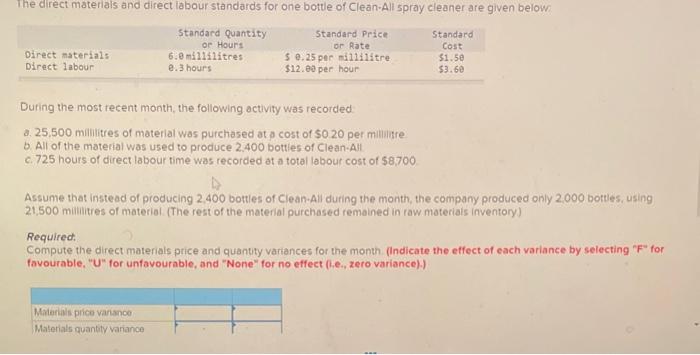Required information [The following information applies to the questions displayed below.] Preble Company manufactures one product. Its variable manufacturing overhead is applled to production based on direct labour-hours, and its standard costs per unit are as follows: The company planned to produce and sell 24,000 units in March. However, during March the company actually produced and sold 30,600 units and incurred the following costs: a. Purchased 170,000kg of raw materials at a cost of $9.00 per kg. All of this material was used in proctuction. b. Direct labour, 68,000 hours at a rate of $18 per hour. c. Total variable manufacturing overhead for the month was $512,040 1. What is the materials price variance for March? (Indicate the effect of each variance by selecting " F " for favorable, "U" for unfavorable, and "None" for no effect (i.e., zero variance.).) 2. What is the materials quantity variance for March? (Indicate the effect of each variance by selecting "F" for favorable, "U" for unfavorable, and "None" for no effect (i.e., zero variance.).) 3. If Preble had purchased 183.000kg of moterials at 59.00 per kg and used 170.000kg in production, what would be the materials price variance for March? (Indicate the effect of each variance by selecting "F" for favorable, "U" for unfavorable, and 'None' for no effect (i.e., zero variance.). Do not round Intermediate calculations.) 4. If Preble had purchased 183,000kg of materials at $9,00 per kg and used 170,000kg in production, what would be the materials quantity variance for March? (Indicate the effect of each variance by selecting "F" for favorable, " U " for unfavorable, and "None" for no effect (i.e., zero variance.). Do not round intermediate calculations.) 5. What is the labour rate variance for March? (indicate the effect of each variance by selecting "F" for favorable, "U" for unfavorable, and "None" for no effect (i.e., zero variance.). Do not round intermediate calculations.) 6. What is the labour efficiency variance for March? (Indicate the effect of each variance by selecting "F" for favorable, "U" unfavorable, and "None" for no effect (i.e., zero variance.). Do not round intermediate calculations.) During the most recent month, the following activity was recorded a. 25.500 mililitres of material was purchased at a cost of $0.20 per milialie b. All of the material was used to produce 2.400 botties of Clean. All c. 725 hours of direct labour time was recorded at a total labour cost of $8700 Assume that instead of producing 2.400 botties of Clean. All during the month, the company produced only 2.000 bottles, using 21,500 mililitres of material. (The rest of the material purchased remained in raw materiais inventory). Required: Compute the direct materials price and quantity variances for the month (Indicate the effect of each variance by selecting "F" for favourable, "U" for unfavourable, and "None" for no effect (L.e., zero variance).)














